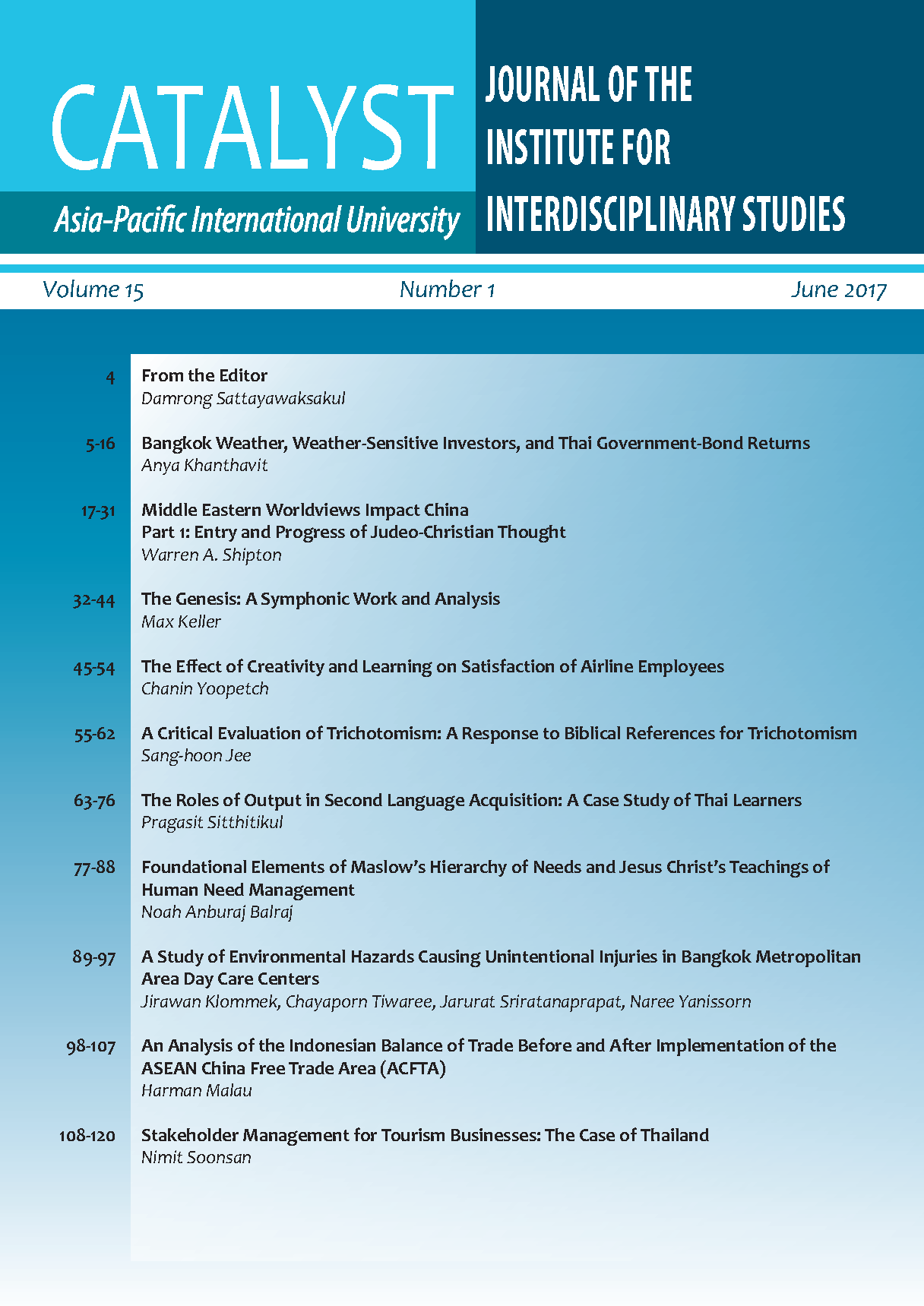An Analysis of the Indonesian Balance of Trade Before and After Implementation of the ASEAN China Free Trade Area (ACFTA)
Main Article Content
Abstract
The aim of this research study was to show whether the implementation of ASEAN-China Free Trade Area (ACFTA) contributes advantages or disadvantages in the Indonesian context by statistically analyzing the balance of trade using t-test (paired t-test) and trend line analysis. The sampling technique of this study was the total exports and imports of Indonesia to and from Brunei Darussalam, China, Malaysia, the Philippines, Singapore, and Thailand from January 2005 to 2014. Data was obtained from the official website of the Indonesian Central Bureau of Statistics. The study found that there was a significant relationship between the Indonesian Balance of Trade before and after implementation of the ACTFA; the result of a 2-tailed test was a value of 0.035. Furthermore, a linear regression line showing the Balance of Trade before and after ACFTA became steeper after the implementation of ACFTA, showing that the Indonesian trade deficit between exports and imports widened after ACFTA. What may be deduced from these findings is that free trade under ACFTA did not improve Indonesia’s Balance of Trade; instead, its trade performance worsened after implementation of ACFTA.
Article Details

This work is licensed under a Creative Commons Attribution-NonCommercial-NoDerivatives 4.0 International License.
Copyright: Asia-Pacific International University reserve exclusive rights to publish, reproduce and distribute the manuscript and all contents therein.
References
Ball, D.; McCulloch, W.; Frantz, P.; Geringer, M.; and Minor, M. (2005). International business: the challenge of global competition (5th edition). New York: McGraw-Hill.
Bhagwati, J., N. (2002) Breaking the borders, Columbia University Academic Commons, Retrieved from http://hdl.handle.net/10022/AC:P:19064.
Brookfield, J. (2003). Globalization and competitive advantage. Strategy & Leadership. Emerald Group Publishing Limited, 31(3), 54-55. Retrieved from http://dx.doi.org/10.1108/sl.2003. 26131cae.003.
Ditjenkpi (2010). ASEAN-China free trade area. Retrieved from http://ditjenkpi.kemendag.go.id/ Umum/Regional/Win/ASEAN%20- %20China%20FTA.pdf.
Edge, K. (1999). Free trade and protection: advantages and disadvantages of free trade, Retrieved from http://www.hsc.csu.edu.au/economics/global_economy/tut7/Tutorial7.html, accessed August 20, 2015.
Frunza, R., Maha, L. G., & Mursa, G. (2009). Globalization & regionalization in international trade. Retrieved fromhttp://dx.doi.org/10.2139/ssrn.1375116.
Goldstein, J., and Martin, L., L. (2000) Legalization, Trade liberalization, and domestic politics: A cautionary note, International organization. Retrieved from http://www.columbia.edu/itc/ sipa/S6800/courseworks/legal_goldstein.pdf.
Heakal, R. (2015). What is international trade? Retrieved from http://www.investopedia.com/ articles/03/112503.asp#ixzz4K1gYNvvc.
Hills, C., & Donker, A. (2004). The free-trade advantage. Optimize, 56-64. Retrieved from http://search.proquest.com/docview/205176827?accountid=13771.
Irwin, D. A. (2001). The brief history of international trade, Retrieved fromhttp://www.econlib.org/ library/Columns/Irwintrade.html, accessed, August 19, 2015.
Joshi, R. M. (2005) International marketing, Oxford University Press, New Delhi and New York
Joshi, R. M. (2009) International business, Oxford University Press, New Delhi and New York.
Juline, P., Joyal, A. & Deshaies, L. (1994). SMEs and international competition: Free Trade Agreement or globalization? Journal of Small Business Management 32(3), 52.
Kapoor, B. (2011). Impact of globalization on human resource management. Journal of International Management Studies, 6(1), 1-8. Retrieved from http://search.proquest.com/ docview/ 867910302?accountid=13771, accessed June 22, 2015.
Lequiller, F., & Blades, D. (2014). Understanding national accounts: Second Edition, OECD Publishing. 139-143 Retrieved from http://dx.doi.org/10.1787/9789264214637-en.
Menperdag: FTA Bisa Dongkrak Kenaikan Ekspor (2010), Kompas. Retrieved from http:// bisniskeuangan. kompas.com/read/2010/01/05/16292334/Menperdag.FTA.Bisa.Dongkrak.Kenaikan.Ekspor.
Pasha, H., A. & Imran, M. (September 2012) The Prospects Indo-Pakistan trade, The Lahore Journal of Economics, 17, 293-313. Retrieved from http://121.52.153.179/JOURNAL/LJE_Vol_17SE_PDF/12%20Pasha%20and%20Imran%20ED%20AAC%2001102012.pdf.
Santoso, S. (2013). Menguasai SPSS 21 di era informasi. PT Elex Media Komputindo. Jakarta.
Setia, A. L. (2009). Statistika untuk bisnis dan ekonomi. Yogyakarta: CV. Andi Offset.
Siregar, S. (2014). Statistik parametric untuk penelitian kuantitaif. Jakarta. Bumi Aksara
Suharyati & Nurdan (2012) Islamic clothes for young generation in cultural globalization era, Majalah Ilmiah Bissotek, 7, 52-58. Retrieved from http://jurnal.pnl.ac.id/wp-content/plugins/Flutter/ files_flutter/1369031570BISSOTEK.pdf.
Sullivan, A., & Sheffrin, S. M. (2003). Economics: principles in action. Upper Saddle River: Pearson Prentice Hall.
Suranovic, S. (2007). A lesson for comparative advantage. Retrieved from https:// internationaleconpolicy.wordpress.com/2007/10/03/a-lesson-on-comparative-advantage/ accessed: 12 September 2016.
Tarmidi, L. T. (2010). Menghadapi tantangan Cina dalam ACFTA. Jurnal Ekonomi Pembangunan Volume 39 No. 1. Hal 63-75. Jakarta.


